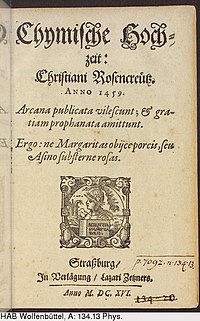Chymical Wedding of Christian Rosenkreutz
by John Crowley
Introductory paragraph
The story follows the Passover and the seven days of unleavened bread exactly. The slaughtering and roasting of the Paschal lamb begins in the evening (near Easter), as does The Chymical Wedding. The Chymical Wedding begins in the evening with CRC sitting at a table with both the Paschal Lamb and the unleavened bread. This would seem to indicate that CRC was Jewish. However, the words "Father of Lights" are curiously in the first paragraph. This phrase, "Father of Lights" appears only once in the King James Bible and it is in the book of James (Jas 1:17). Below is the opening paragraph of The Chymical Wedding;The nine Lords
The nine Lords are nine books of the New Testament, I Peter, II Peter, James, Jude, I John, II John, III John, the Gospel of John, and the Revelation. CRC believed that the Gospel of John is the only gospel that is historically plausible, and that it is the unleavened bread and its relationship to the Passover that truly divides John's gospel from the synoptic Gospels. The nine lords were bound together with the rest that were at the table (27 total) and CRC cried.The four paths
In the second chapter CRC sits down to rest under three tall cedars. There is a tablet fastened to one of them which tells of four paths. An important point is that it's the Bridegroom (Bible) that is offering these paths. It reads as follows: The first path leads to rocky places and this is reminiscent of Peter, "the rock" as he's portrayed in the synoptic gospels. The second path in the text is the path taught in John's gospel, as CRC is told not to turn to the left or right on this path and John's is the only account not to mention two men crucified to the right and to the left of Jesus while on the cross as thieves (John 20:18). The third path would be the general letters of Peter, James, Jude, and John. In the letter of James we find reference to the royal way or royal law (Jas 2:8). In the second letter of Peter we find the only reference to one in a thousand (II Pet 3:8). The fourth path is the letters of Paul. This is where one finds the teaching of the dead raised incorruptible (I Cor 15:52), and the only place that the word "consuming" appears in the New Testament (Heb 12:29).The story then continues, Whereupon I presently drew out my bread and cut a slice of it. It shouldn't go unnoticed that, after reading this tablet, CRC cuts the bread. Symbol XXIV of the symbols of Pythagoras indicates "Never break the bread". Bread is broken in the gospels of Mark, Luke, and Matthew; however bread is never broken in John's gospel. Bread is also broken in the letters of Paul and the Book of Acts; however bread is never broken in the general letters of Peter, James, Jude and John.
As the story proceeds it's evident that CRC took the second path with the following words, yet I still proceeded with my compass, and would not budge one step from the Meridian Line. Meaning that CRC didn't turn to the left or right. It's also noteworthy that CRC says, "I patiently took up my cross, got up onto my feet". Only in John's gospel did Jesus bear the cross. It was Simon of Cyrene who bore the cross for Jesus in Mark, Luke and Matthew's gospels. But at the same time in Mark's gospel Jesus offered a man "take up the cross, and follow me"(Mark 10:21).
